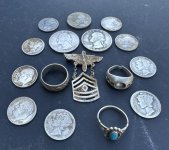Rattlehead
Forum Supporter
Something I should’ve mentioned as a negative in my original review is the coil charging clip. It sucked on the original Deus and it sucks on the D2. I don’t like it for a few reasons: 1) It gets hung up on the lip of the coil cover. 2) It’s finicky about making a good connection. Especially if the coil has a little dirt on it. 3) If you use a coil balancer like I do, it’s difficult to get the charging clip on due to the cable being plugged into the side.
I recently picked up one of these from DetectingDoodads.com:

It solves all of the issues with the OEM clip. Goes on easy, makes good connection, and has the cable plugged in from the top. Money well spent!
Makes me wonder why XP doesn’t use a better design like this one. I guess for the same reason they don’t include a functional stand or a center mounted coil. It’s a great detector, but I think the designers missed the boat on a few things.
Anyway, D2 silver update: 10 more since my last post bringing my total to 65 FTY.

Sent from my iPhone using Tapatalk
I recently picked up one of these from DetectingDoodads.com:

It solves all of the issues with the OEM clip. Goes on easy, makes good connection, and has the cable plugged in from the top. Money well spent!
Makes me wonder why XP doesn’t use a better design like this one. I guess for the same reason they don’t include a functional stand or a center mounted coil. It’s a great detector, but I think the designers missed the boat on a few things.
Anyway, D2 silver update: 10 more since my last post bringing my total to 65 FTY.

Sent from my iPhone using Tapatalk






